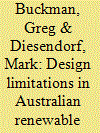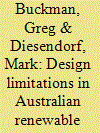|
|
|
Sort Order |
|
|
|
Items / Page
|
|
|
|
|
|
|
| Srl | Item |
| 1 |
ID:
096646


|
|
|
|
|
| Publication |
2010.
|
| Summary/Abstract |
Renewable electricity is pivotal to the medium and long-term reduction of Australia's greenhouse gas (GHG) emissions, if deep cuts in them are eventually implemented. This paper examines the effectiveness of the principal existing policies that could potentially promote the expansion of renewable electricity (RElec) in Australia: the expanded Renewable Energy Target (RET); the proposed emissions trading scheme (ETS); and the state and territory-based feed-in tariffs. We find the effectiveness of RET is severely eroded by the inclusion of solar and heat pump hot water systems; by the inclusion of 'phantom' tradable certificates; and by high electricity consumption growth. We also find that the ETS will not produce a high enough carbon price to assist most RElec technologies before 2020; and that most of the feed-in tariffs exclude large-scale RElec and will give little assistance to small-scale RElec because they are mostly net tariffs. Unless there is a major revision of its RElec policy mechanisms, Australia will fail to reach its renewable electricity target and in particular will fail to build up its solar generation capacity which could be a major source of future deep cuts in the country's electricity generation emissions.
|
|
|
|
|
|
|
|
|
|
|
|
|
|
|
|
| 2 |
ID:
097480


|
|
|
|
|
| Publication |
2010.
|
| Summary/Abstract |
Renewable electricity is pivotal to the medium and long-term reduction of Australia's greenhouse gas (GHG) emissions, if deep cuts in them are eventually implemented. This paper examines the effectiveness of the principal existing policies that could potentially promote the expansion of renewable electricity (RElec) in Australia: the expanded Renewable Energy Target (RET); the proposed emissions trading scheme (ETS); and the state and territory-based feed-in tariffs. We find the effectiveness of RET is severely eroded by the inclusion of solar and heat pump hot water systems; by the inclusion of 'phantom' tradable certificates; and by high electricity consumption growth. We also find that the ETS will not produce a high enough carbon price to assist most RElec technologies before 2020; and that most of the feed-in tariffs exclude large-scale RElec and will give little assistance to small-scale RElec because they are mostly net tariffs. Unless there is a major revision of its RElec policy mechanisms, Australia will fail to reach its renewable electricity target and in particular will fail to build up its solar generation capacity which could be a major source of future deep cuts in the country's electricity generation emissions.
|
|
|
|
|
|
|
|
|
|
|
|
|
|
|
|
| 3 |
ID:
118843


|
|
|
|
|
| Publication |
2013.
|
| Summary/Abstract |
We investigate the impacts on the biophysical economy, employment and environment of a transition scenario to an energy-efficient, 100% renewable electricity (RE) system by 2060, based on wind, solar and biomass technologies, and an introduction of electric vehicles. We employ a CSIRO process-based model of the physical activity of Australia's economy and environmental resources, the Australian Stocks and Flows Framework. The RE systems are assumed to be manufactured in Australia to identify possible employment benefits. In comparison with the business-as-usual (BAU) scenario, on a national scale, the RE scenario has much lower economy-wide net emissions, remaining below contemporary levels and becoming zero in the electricity sector by 2060. Compared with BAU, the RE scenario also has significantly lower industrial water use, somewhat higher materials use, slightly lower unemployment, lower net foreign debt (relative to a GDP proxy) and, resulting from the growth in electric vehicles, reduced oil imports. The GDP per capita growth, based on the physical stocks of capital and labour, is virtually the same in both scenarios. Hence, from the viewpoint of the biophysical economy, there are no major barriers to implementing policies to facilitate the transition to a 100% renewable electricity system for Australia.
|
|
|
|
|
|
|
|
|
|
|
|
|
|
|
|
| 4 |
ID:
122746


|
|
|
|
|
| Publication |
2013.
|
| Summary/Abstract |
Climate science suggests that, to have a high probability of limiting global warming to an average temperature increase of 2 °C, global greenhouse gas emissions must peak by 2020 and be reduced to close to zero by 2040. However, the current trend is heading towards at least 4 °C by 2100 and little effective action is being taken. This paper commences the process of developing contingency plans for a scenario in which a sudden major global climate impact galvanises governments to implement emergency climate mitigation targets and programs. Climate activists assert that rapid mitigation is feasible, invoking the scale and scope of wartime mobilisation strategies. This paper draws upon historical accounts of social, technological and economic restructurings in several countries during World War 2 in order to investigate potential applications of wartime experience to radical, rigorous and rapid climate mitigation strategies. We focus on the energy sector, the biggest single contributor to global climate change, in developed and rapidly developing countries. We find that, while wartime experience suggests some potential strategies for rapid climate mitigation in the areas of finance and labour, it also has severe limitations, resulting from its lack of democratic processes.
|
|
|
|
|
|
|
|
|
|
|
|
|
|
|
|
| 5 |
ID:
125415


|
|
|
|
|
| Publication |
2013.
|
| Summary/Abstract |
Least cost options are presented for supplying the Australian National Electricity Market (NEM) with 100% renewable electricity using wind, photovoltaics, concentrating solar thermal (CST) with storage, hydroelectricity and biofuelled gas turbines. We use a genetic algorithm and an existing simulation tool to identify the lowest cost (investment and operating) scenarios of renewable technologies and locations for NEM regional hourly demand and observed weather in 2010 using projected technology costs for 2030. These scenarios maintain the NEM reliability standard, limit hydroelectricity generation to available rainfall, and limit bioenergy consumption. The lowest cost scenarios are dominated by wind power, with smaller contributions from photovoltaics and dispatchable generation: CST, hydro and gas turbines. The annual cost of a simplified transmission network to balance supply and demand across NEM regions is a small proportion of the annual cost of the generating system. Annual costs are compared with a scenario where fossil fuelled power stations in the NEM today are replaced with modern fossil substitutes at projected 2030 costs, and a carbon price is paid on all emissions. At moderate carbon prices, which appear required to address climate change, 100% renewable electricity would be cheaper on an annual basis than the replacement scenario.
|
|
|
|
|
|
|
|
|
|
|
|
|
|
|
|
| 6 |
ID:
113472


|
|
|
|
|
| Publication |
2012.
|
| Summary/Abstract |
As a part of a program to explore technological options for the transition to a renewable energy future, we present simulations for 100% renewable energy systems to meet actual hourly electricity demand in the five states and one territory spanned by the Australian National Electricity Market (NEM) in 2010. The system is based on commercially available technologies: concentrating solar thermal (CST) power with thermal storage, wind, photovoltaic (PV), existing hydro and biofuelled gas turbines. Hourly solar and wind generation data are derived from satellite observations, weather stations, and actual wind farm outputs. Together CST and PV contribute about half of total annual electrical energy supply.
A range of 100% renewable energy systems for the NEM are found to be technically feasible and meet the NEM reliability standard. The principal challenge is meeting peak demand on winter evenings following overcast days when CST storage is partially charged and sometimes wind speeds are low. The model handles these circumstances by combinations of an increased number of gas turbines and reductions in winter peak demand. There is no need for conventional base-load power plants. The important parameter is the reliability of the whole supply-demand system, not the reliability of particular types of power plants.
|
|
|
|
|
|
|
|
|
|
|
|
|
|
|
|
|
|
|
|
|